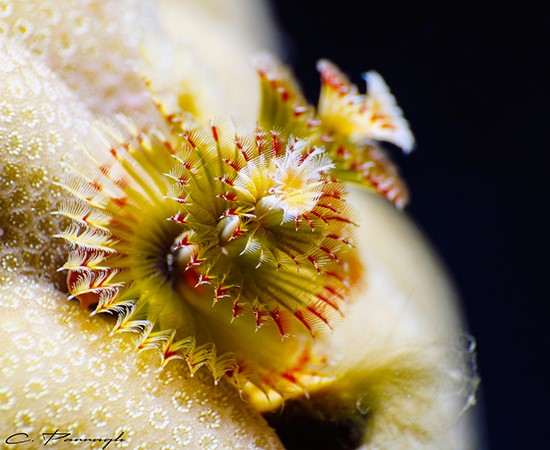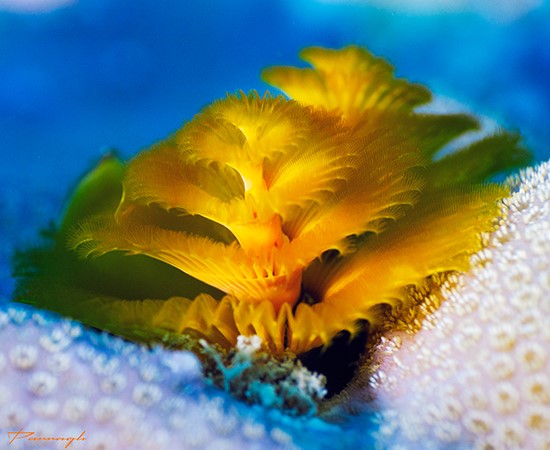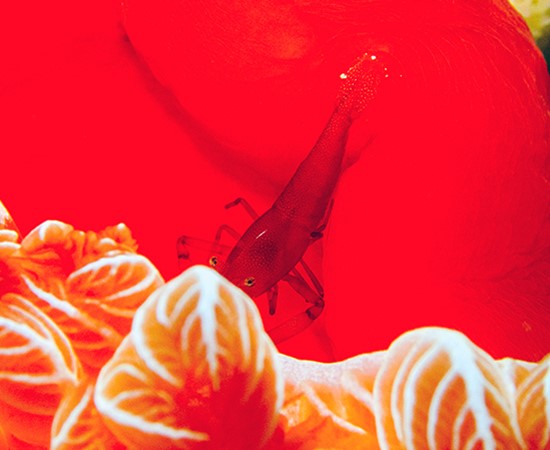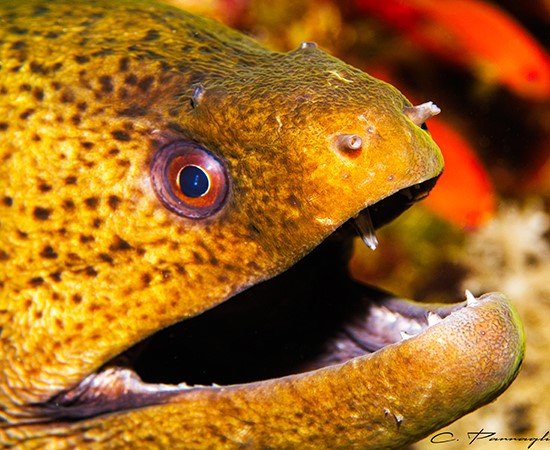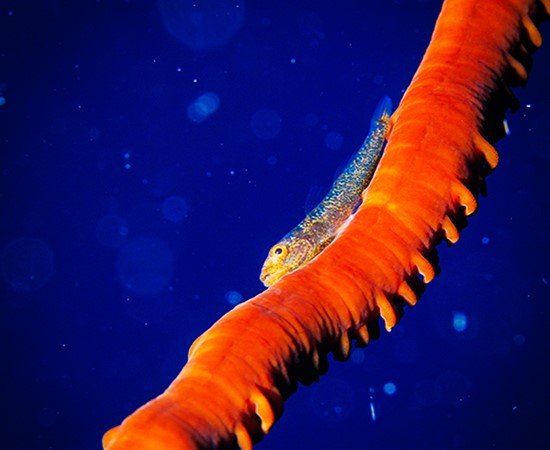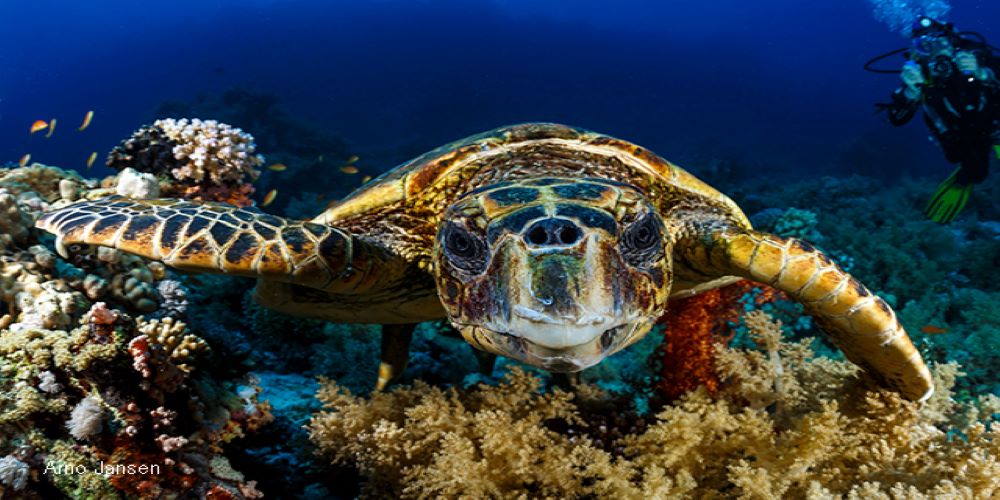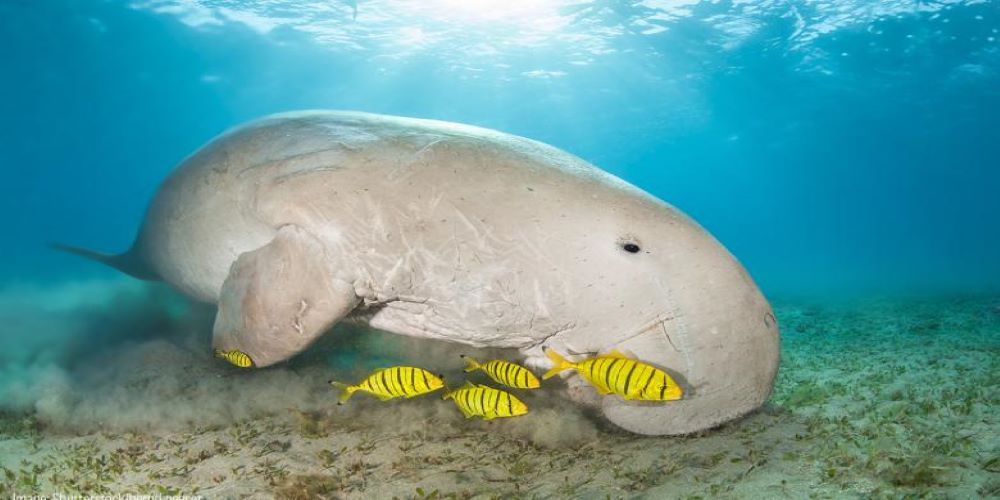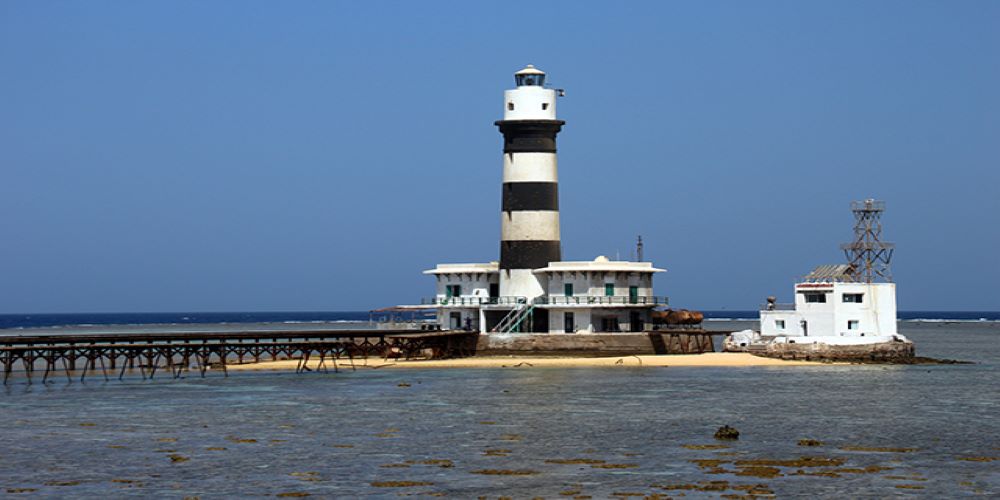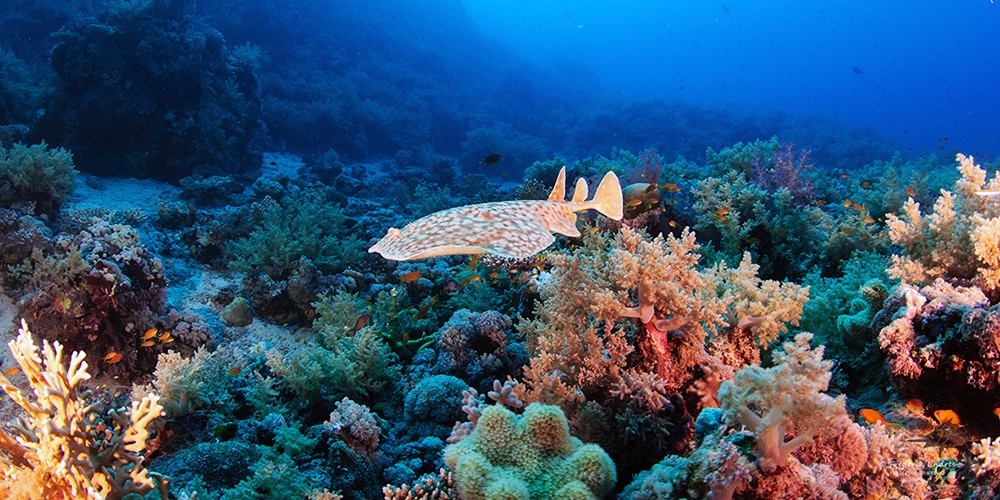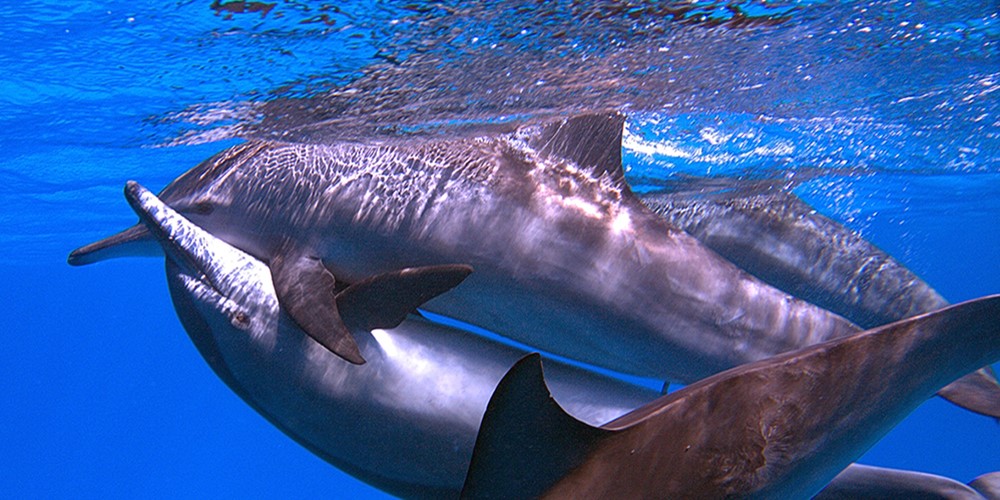Daedalus-Fury Shoals-Elphinstone
- With a length of 600 to 700 metres and a width of 100 to 300 metres (north to south), the Daedalus Reef is a very large reef. In the eastern section and in a depth range of 18 and 40 metres, we'll find a lagoon-like plateau from which, depending on the current, we can usually watch multiple groups of hammerhead sharks swimming at open sea.
- The Fury Shoals is an huge area with several famous reefs like Shaab Sataya, Shaab Malahy, Shaab Claude. Depending on the wheather conditions we spend one day in that huge area. It is such a great area, that we offer a trip, where we only dive at Fury Shoals.
- The Elphinstone Reef has a total length of approx. 600 metres and a width of 70 metres. It is known for its drop-offs and sightings of hammerhead and oceanic whitetip sharks.
Abu Dabab
A unique structure makes this reef so remarkable: there are notches and small caves, also a stunning coral garden. All kinds of emperor and banner fish are at home here, but also reef sharks. Due to its location and its maximum depth of 16m, Abu Dabab I is excellent for relaxed day and exciting night dives.
In the south, almost exactly in the middle, there is a single block. There you will see bright red lionfish, as well as feather stars and at night basket stars. In addition, dolphins keep passing by in the south. In the southeast there is another collection of ergs with soft and hard corals, around which there are occasional hawksbill turtles and sharks.
To the north is the famous "Heaven one". Many stories are told around this wreck. Not far away you will find anemone colonies and a cave system overgrown with ancient corals, before diving into two lagoons on the west side with mighty corals and schools of barbels and snappers.
On the west side, an ancient coral formation stretches south with some boulders where reef sharks like to sleep. At the edge of the reef you can find remains of amphorae.
Shaab Shona
The lagoon is formed from a dried up river (wadi) and with a diameter of 150m between 5 and 45m deep. You can still see the wadi in the middle as a channel that rises to the north and south. In the north there is a plateau whose edges drop from 14 to over 40m.
The north side is characterized by boulders where you can find ghost pipefish, long-jawed makerels, glassfish and crocodile fish, but of course also as many different coral species. They reach from the reef edge partly down to 20m and are covered with life.
Daedalus
With a length of 600 to 750m and a width of 100m in the north and 300m in the south, Daedalus is a very large reef. In the south there is a lighthouse that guides the ships at night. Here you can shop, stretch your feet or climb the lighthouse. On the north side there is a steep wall, which towards the east on a depth between 18 and 40m changes into several lagoon like plateaus. There in the blue water you can find the hammerhead sharks. Usually, depending on the current, several groups of 12 to 25 animals each can be found.
Almost all boats anchored at Daedalus will send their Zodiacs north in the early morning hours. The best place to go in the water is at the northwest corner.
It is worth - always in sight of the reef - to dive a bit into the blue water and just wait at 20 or 25 meters depth. If there is nothing to be seen, dive calmly at the same depth in southeast direction around the reef top. On the east side there are two lagoons, near which the hammerhead sharks usually come out of the depth. At the first moment you will usually see only one animal. It will dive past you at some distance and lie down on its side to show its strength. Stay where you are. Do not go deeper or follow the shark - it will disappear into the depths. However, if you have waited patiently, the other animals in the group will come out of the depths and attempt to get close to you. If you get too close to them, they will dive away. But if you stay where you are, or even ascend a few meters - yes, yes, the NDL time - the animals will usually follow. Then you have the opportunity to enjoy this spectacle for up to 20 minutes.
Nearby is also the so called "Manta Point" with its colorful reef wall. The whole east side is a first class spot. You should always look below you into the depth or into the blue water - there will always be big hunters in sight.
The west side with its notches is home to one of the largest anemone colonies in the Red Sea. More than 200, with their red outer shell and delicate yellow to greenish coloring, have attached themselves to the reef on a width of just 10 meters in the narrowest of spaces. This colony reaches down to a depth of more than 50m. But further south it finally takes your breath away. There sits a gigantic hard coral, at whose sight one feels tiny: Like a waterfall it falls down from 4 to 19m. Unfortunately, the first damages are already visible.
In the south of Daedalus there is a plateau with big and small boulders - a good place for the thresher shark. Nearby is rubble and steel from the lighthouse. Moray eels and groupers slumber in it. You can also find turtles, gray reef sharks, hunting mackerel and tuna, and of course stonefish and snails.
At the southern drop-off edge of the plateau you can find a small colony of anemones. The special thing about it is the coexistence of different colored species in a small area. In the upper area one often encounters deep sea sharks, such as the Oceanic white tip shark and the silky shark.
Daedalus is also an outer reef and marine park. Apart from the general regulations, anyone going diving here should be able to cope with changing, sometimes strong currents, high waves and Zodiacs. In addition, a deep dive specialty is recommended.
Shaab Claude
Shaab Claude is about 150m long and 60m wide with a maximum depth of 24m. Boats usually anchor in the south, because there is the cave entrance in 10m depth. Also most of the fish can be found in the southern part of the reef. Here live e.g. batfish, triggerfish, bannerfish, barbels and snappers. Also big napoleon wrasse are not rare.
Often a current from the north makes diving on the west side above the coral garden difficult or impossible. After a bumpy ride by Zodiac to the channel and the anemone colonies, you will be rewarded with a nice drift dive on the east or west side.
Shaab Malahi
Shaab Malahi has a length of 100m and a width of 60m. The depth varies from 22m to 6m in the inner area. Only on the east side after about 50m there is a drop-off edge.
The reef is a maze of boulders that enclose the area in an almost circular fashion. Some of them rise 16 to 20m steeply and in the upper area an overhang has formed.
The labyrinth of blocks is most relaxed to dive with a guide, moreover, the diving depth varies often and sometimes extremely, so that the ears have to give maximum performance here.
Shaab Malahi gives you the opportunity to observe the formation of reefs, because due to the weather this reef is always in motion. Here you should watch out for falling objects in the overgrown corridors and caves.
Behind and below the boat is a sandy area that hosts some nice big boulders at about 20 meters depth, running far to the south. To its southeast are two blocks that look like they are connected to table coral. Here and a little further north there are schools of banner fish. But there is a lot to discover in this area in general.
Shaab Sataya
The mooring of most boats is in the north at the entrance to the lagoon. The lagoon is not so interesting, because there is only sand. But it is a huge lagoon that leads to the "Dolphin Reef", where you can meet dolphins very often. Usually after the dive a small detour is made into the lagoon to give the divers the opportunity to snorkel with dolphins.
At Shaab Sataya South there are 3 possible tours, but only 2 of them are interesting - the third one is rather an exception.
Entrance to the lagoon: Night dives are often done in the 10 m area under the boat. A nice area are the blocks north of the boats to the entrance of the lagoon.
Itinerary
ATTENTION: The tour description is only a suggestion. Which dive sites are dived on the tour depends on many factors, including wind and weather.
Arrival
After arrival in Hurghada transfer to the boat.
Check in, dinner and spending the first night on board in the marina.
Departure
Departure in the morning.
Familiarization of the boat,
Diving, safety and equipment briefing.
Dives at Abu Dabab
Daedalus Reef
Dives at Daedalus Reef
Daedalus Reef
Dives at Daedalus Reef
Sataya
Dives at
Sataya south
El Mahali
Shaab Claude
Night dive at Gota Bohar
Elphinstone Reef
Dives at
Elphinstone Reef north
Elphinstone Reef south
Abu Dabab
Night dive at Shaab /Marsa Shona
Return
Two dives at Shaab/Marsa Shona
Return to the port.
For safety reasons you should not dive 24 hours before your flight home.
Check out
Breakfast and check out no later than 10 am.
Transfer to the airport or hotel.

 ENGLISH
ENGLISH
 РУССКИЙ
РУССКИЙ
 DEUTSCH
DEUTSCH

